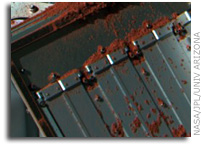Soil Studies Continue at Phoenix Mars Lander Site

Vibration of the screen above a laboratory oven on NASA’s Phoenix Mars Lander on Saturday, Aug. 9, succeeded in getting enough soil into the oven to begin analysis. Commands were sent for the lander’s Thermal and Evolved-Gas Analyzer (TEGA) to begin analysis Sunday of the soil sample from a trench called “Rosy Red.”
Phoenix’s robotic arm delivered soil Thursday from the Rosy Red trench through a narrow opening to a screen above the No. 5 oven on the lander’s TEGA. A few particles of the sample passed through the screen on Thursday, but not enough to fill the oven and allow analysis of the sample to begin. The Phoenix team sent commands for TEGA to vibrate the screen again on Friday, and more material reached the oven, though still not enough to proceed with analysis.
“There appear to be clumps blocking the opening,” Doug Ming of NASA Johnson Space Center, Houston, the Phoenix team’s science lead, said on Friday. “However, we have seen in the past that when this soil sits for a while, it disperses. We intend to fill an oven with this material, either by additional vibration of the same screen or by opening doors to one of the other TEGA cells.”
Friday activities by the spacecraft included extending the width of an exploratory trench informally named “Neverland,” which extends between two rocks on the surface of the ground.
The lander last week also made overnight measurements of conductivity in the Martian soil. The conductivity measurements completed Wednesday, Aug. 6, ran from the afternoon of Phoenix’s 70th Martian day, or sol, after landing to the morning of Sol 71. A fork-like probe inserted into the soil checks how well heat and electricity move through the soil from one prong to another.
The Phoenix mission is led by Peter Smith from The University of Arizona with project management at JPL, and development partnership at Lockheed Martin, located in Denver. International contributions come from the Canadian Space Agency; the University of Neuchatel, Switzerland; the universities of Copenhagen and Aarhus in Denmark; the Max Planck Institute in Germany; and the Finnish Meteorological Institute. The California Institute of Technology in Pasadena manages JPL for NASA.
WEB LINKS:









